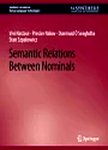版权所有:内蒙古大学图书馆 技术提供:维普资讯• 智图
内蒙古自治区呼和浩特市赛罕区大学西街235号 邮编: 010021

丛 书 名:Synthesis Lectures on Human Language Technologies
版本说明:1
I S B N:(电子) 9783031021480
出 版 社:Springer Cham
出 版 年:1000年
页 数:XII, 107页
主 题 词:Artificial Intelligence Natural Language Processing (NLP) Computational Linguistics
摘 要:People make sense of a text by identifying the semantic relations which connect the entities or concepts described by that text. A system which aspires to human-like performance must also be equipped to identify, and learn from, semantic relations in the texts it processes. Understanding even a simple sentence such as Opportunity and Curiosity find similar rocks on Mars requires recognizing relations (rocks are located on Mars, signalled by the word on) and drawing on already known relations (Opportunity and Curiosity are instances of the class of Mars rovers). A language-understanding system should be able to find such relations in documents and progressively build a knowledge base or even an ontology. Resources of this kind assist continuous learning and other advanced language-processing tasks such as text summarization, question answering and machine translation. The book discusses the recognition in text of semantic relations which capture interactions between base noun *** a brief historical background, we introduce a range of relation inventories of varying granularity, which have been proposed by computational linguists. There is also variation in the scale at which systems operate, from snippets all the way to the whole Web, and in the techniques of recognizing relations in texts, from full supervision through weak or distant supervision to self-supervised or completely unsupervised methods. A discussion of supervised learning covers available datasets, feature sets which describe relation instances, and successful algorithms. An overview of weakly supervised and unsupervised learning zooms in on the acquisition of relations from large corpora with hardly any annotated data. We show how bootstrapping from seed examples or patterns scales up to very large text collections on the Web. We also present machine learning techniques in which data redundancy and variability lead to fast and reliable relation extraction.